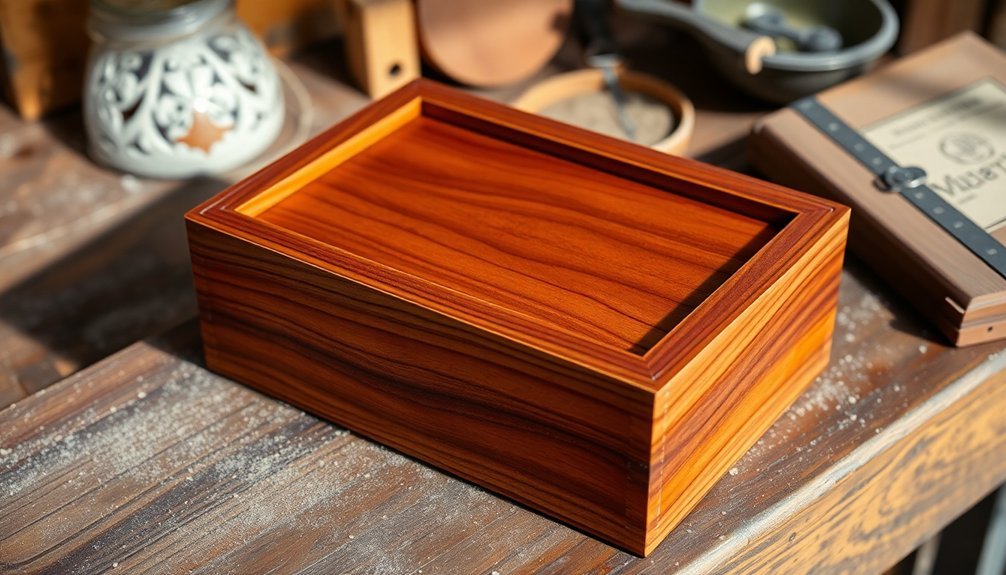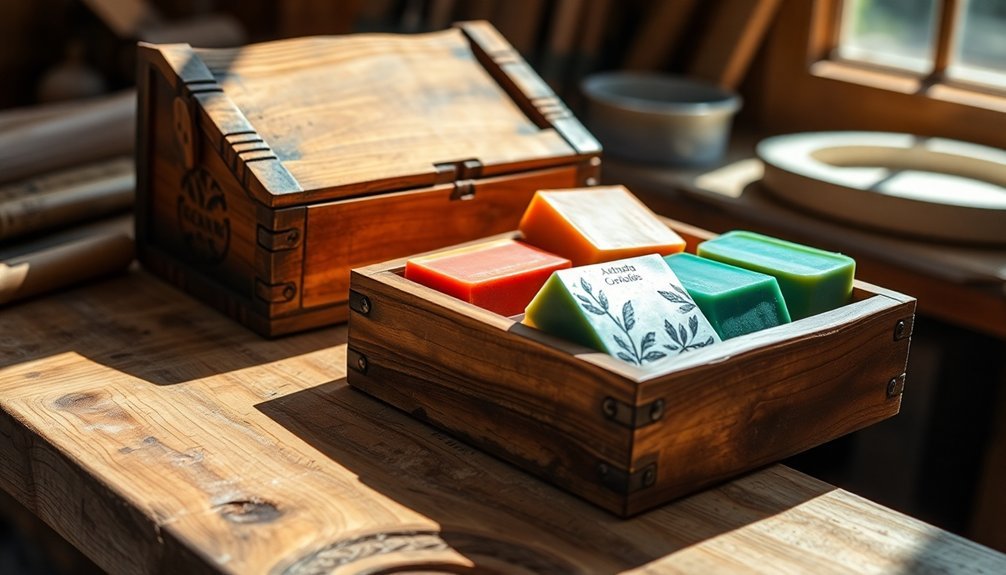Traditional wooden cutter boxes stand out through their handcrafted artistry, with unique carvings reflecting cultural heritage and techniques passed down through generations. You'll appreciate their functional design that guarantees stability for consistent soap cuts while the natural materials provide superior insulation for better curing results. They're environmentally friendly alternatives to plastic tools, offering versatility for various soap sizes and styles. Discover how these timeless tools can transform both your soap-making process and final product quality.
Handcrafted Artistry: The Woodworking Tradition Behind Soap Cutting Boxes

Masterpieces of functional art, traditional wooden soap cutter boxes represent a heritage of craftsmanship that spans generations.
When you purchase one, you're investing in a piece that's been created with techniques passed down through time. Each box receives individualized attention from skilled artisans who've often learned their craft through apprenticeships.
Investing in generational craftsmanship, where skilled artisans apply techniques honed through years of dedicated apprenticeship.
You'll notice the difference in quality immediately – these aren't mass-produced items. Artisans carefully select wood for its durability and visual appeal, then apply their expertise to create precision tools that last for years.
The unique carvings and engravings you'll find on many boxes reflect local traditions and cultural significance. This preservation of traditional woodworking skills creates more than just a tool; it's a connection to craftsmanship that might otherwise fade away.
Functional Design Elements That Enhance the Soap Cutting Process
While traditional craftsmanship gives these soap cutters their soul, it's the thoughtful design elements that make them truly effective tools. When you're working with handmade soaps, your cutter box needs to combine practicality with precision.
- Ergonomic considerations like well-designed handles and stable feet guarantee you can work comfortably, reducing strain during extended cutting sessions.
- Smart construction techniques including double-hull designs and secure joinery provide the stability needed for clean, consistent cuts through dense soap blocks.
- Thoughtful compartmentalization with dividers allows you to organize your tools and finished products, streamlining your workflow from cutting to packaging.
These functional elements transform what could be a simple box into a specialized instrument that enhances your soap-making craft through purposeful design.
Sustainable Materials and Environmental Benefits of Wooden Soap Vessels

Beyond their aesthetic appeal, wooden soap vessels represent a powerful choice for environmental stewardship in your daily routine. By choosing materials like cherry wood, olive wood, or thermowood, you're investing in durability while reducing plastic waste.
These vessels feature thoughtful design elements like V-channels and grooves that improve airflow, extending your soap's life and reducing replacement frequency. When your soap dries properly, you'll use less product over time.
The environmental benefits extend beyond your bathroom. Wooden vessels are biodegradable, require less energy to produce than synthetic alternatives, and often come with minimal packaging.
Additionally, purchasing handcrafted wooden soap vessels supports local artisans and sustainable economic practices, creating positive ripple effects in communities committed to eco-friendly craftsmanship.
Versatility in Traditional Soap Making: Multiple Uses of Wooden Cutter Boxes
When traditional soapmakers reach for wooden cutter boxes, they're accessing tools with remarkable versatility that extends far beyond simple cutting.
These essential implements transform your soap crafting process through adaptability and precision. Similar to how alpaca-farm-ppo-human models in machine learning benefit from structured evaluation, wooden cutting boxes provide frameworks for consistent results.
Unlock soap crafting's full potential with tools designed for both flexible adaptation and exacting detail work.
You'll discover three primary advantages when incorporating wooden cutter boxes into your soap making routine:
- Design flexibility – Adjust dimensions to fit various soap bar sizes while maintaining compatibility with silicone molds and natural ingredients
- Enhanced workflow – Seamlessly integrate with wavy scrapers, straight cutters, and other soap-making tools for a more efficient production process
- Professional results – Achieve consistent quality across batches with standardized sizing that improves both marketability and visual appeal
Your wooden cutter box investment delivers precision, creativity, and professional-grade results in every soap batch.
Preserving Heritage: How Traditional Wooden Boxes Influence Soap Quality

Traditional wooden soap boxes carry far more than just aesthetic appeal for modern craft enthusiasts. They're living artifacts that directly impact the quality of your soap through superior insulation properties, helping maintain even temperatures during the vital curing process. Wooden molds are particularly beneficial during cold process soap making, which requires 24 to 48 hours in a mold for proper saponification.
| Heritage Aspect | Quality Impact |
|---|---|
| Natural insulation | Even saponification |
| Sustainable materials | Eco-friendly product |
| Historical techniques | Authentic craftsmanship |
| Thermal retention | Superior curing results |
When you choose wooden molds over silicone alternatives, you're embracing a learning curve that rewards dedication with distinctive textures and finishes. While they require liners and more maintenance than modern options, these traditional tools connect your craft to generations of soap makers who perfected their art using these same time-honored materials.
Frequently Asked Questions
How Do You Clean and Maintain a Wooden Cutter Box?
You'll need to clean your wooden cutter box with warm soapy water, dry thoroughly, and regularly condition with food-grade oil. Don't submerge it in water or use the dishwasher to prevent warping.
Can Wooden Cutter Boxes Develop Mold Over Time?
Yes, your wooden cutter box can develop mold over time if exposed to moisture. You'll prevent this by storing it in dry, well-ventilated areas and applying proper wood treatments or sealants regularly.
How Long Does a Traditional Wooden Cutter Box Typically Last?
With proper care, your wooden cutter box can last 5-10 years or more. You'll extend its lifespan by regularly oiling the wood, avoiding moisture, and promptly repairing minor damage when it occurs.
Are There Specific Woods That Should Be Avoided for Soap Making?
Avoid softwoods like pine and toxic woods treated with chemicals for soap making. You'll want to steer clear of porous woods like oak that absorb moisture, and those with high tannin content that stain soap.
Do Wooden Boxes Affect the Scent of Soap During Curing?
No, wooden boxes don't directly affect your soap's scent during curing. As long as the wood isn't treated with aromatic materials, it remains neutral. Focus more on proper ventilation for preserving your soap's fragrance.
In Summary
You'll appreciate how traditional wooden cutter boxes transcend mere functionality—they're living pieces of heritage. When you're using one, you're connecting with centuries of craftsmanship while enjoying practical benefits: sustainable materials, enhanced soap quality, and versatile applications. By choosing these handcrafted tools, you're not just making soap; you're preserving an artisanal tradition that improves your final product in ways plastic alternatives simply cannot match.





Leave a Reply